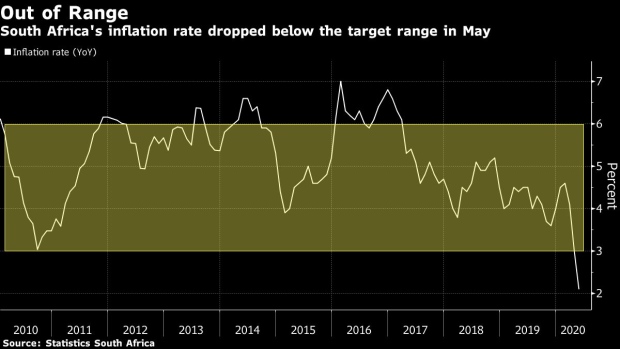Jul 15, 2020
South Africa Inflation Drops Below Target First Time in 15 Years
, Bloomberg News

(Bloomberg) --
South Africa’s inflation rate dropped below the central bank’s target range for the first time in 15 year in May due to lower fuel prices
Consumer prices rose 2.1% from a year earlier compared with 3% in April, the Pretoria-based Statistics South Africa said Wednesday in a statement on its website. That’s the lowest since September 2004. The median estimate of 15 economists in a Bloomberg survey was 2.2%. Prices fell 0.6% in the month, the biggest drop since November 2003.
Key Insights
- While inflation slowed more than projected, it may not prompt aggressive interest-rate cuts, with Reserve Governor Lesetja Kganyago saying last month the monetary policy committee will look through a temporary drop below 3% and only step in if it becomes a protracted event. The MPC has reduced the repurchase rate by 275 basis points this year, taking it to the lowest level since introduced in 1998.
- The Reserve Bank forecasts an economic contraction of 7% in 2020 and projected average inflation below 3% for the second and third quarter. While the rate of price growth is forecast to peak at an average of 5% in the second quarter of next year, it will drop back to below 4.5%, where the monetary policy committee prefers to anchor it, for most of 2022.
- The slowdown was driven by a decrease in the fuel price in May. The cost of gasoline was 27% lower than a year earlier. Higher food costs added to the headline number, with price growth accelerating to 4.8% from 4.6%.
- Annual core inflation, which excludes the prices of food, non-alcoholic drinks, fuel and electricity, slowed to a nine-year low of 3.1% from 3.2% in April.
- Prices for items including food, non-alcoholic beverages and household and personal care products, equivalent to about 20% of the weight of the inflation basket, were collected via online methods because lockdown restrictions only allowed Statistics South Africa to deploy its fieldworkers at the end of May. It also used substituted values for products that weren’t legally available for sale during April and May’s restrictions. Banned products made up 23.7% of the weight of the headline index.
©2020 Bloomberg L.P.